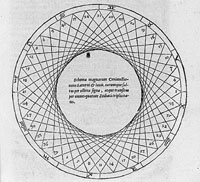Kepler and Astrology
 This diagram from the Mysterium Cosmographicum shows the recurrence pattern of the conjunction of Saturn and Jupiter, a major astrological event. This pattern led to Kepler's discovery of the nested polyhedra.
This diagram from the Mysterium Cosmographicum shows the recurrence pattern of the conjunction of Saturn and Jupiter, a major astrological event. This pattern led to Kepler's discovery of the nested polyhedra.Image by kind permission of the Master and Fellows of Trinity College, Cambridge.
Kepler disdained astrologers who pandered to the tastes of the common man without knowledge of the abstract and general rules, but he saw compiling prognostications as a justified means of supplementing his meagre income. Yet, it would be a mistake to take Kepler's astrological interests as merely pecuniary. As one historian, John North, put it, 'had he not been an astrologer he would very probably have failed to produced his planetary astronomy in the form we have it.'
Kepler believed in astrology in the sense that he was convinced that planetary configurations physically and really affected humans as well as the weather on earth. He strove to unravel how and why that was the case and tried to put astrology on a surer footing, which resulted in the On the more certain foundations of astrology (1601). In The Intervening Third Man, or a warning to theologians, physicians and philosophers (1610), posing as a third man between the two extreme positions for and against astrology, Kepler advocated that a definite relationship between heavenly phenomena and earthly events could be established.
At least 800 horoscopes drawn up by Kepler are still extant, several of himself and his family, accompanied by some unflattering remarks. As part of his duties as district mathematician to Graz, Kepler issued a prognostication for 1595 in which he forecast a peasant uprising, Turkish invasion and bitter cold, all of which happened and brought him renown. Kepler is known to have compiled prognostications for 1595 to 1606, and from 1617 to 1624. As court mathematician, he explained to Rudolf II the horoscopes of the Emperor Augustus and Mohammed, and gave astrological prognosis for the outcome of a war between the Republic of Venice and Paul V. In the On the new star (1606) Kepler explicated the meaning of the new star of 1604 as the conversion of America, downfall of Islam and return of Christ. The De cometis libelli tres (1619) is also replete with astrological predictions.